|
|
|
Sort Order |
|
|
|
Items / Page
|
|
|
|
|
|
|
| Srl | Item |
| 1 |
ID:
084229
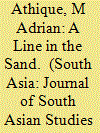

|
|
|
|
|
| Publication |
2008.
|
| Summary/Abstract |
This article examines the visualisation and narrative construction of the India-Pakistan border, and human interactions across that liminal space, as depicted in two films directed by J.P. Dutta, the high-profile, multiple award-winning war film Border (1997) and his subsequent feature Refugee (2000), which was more loosely described in its publicity literature as 'a human story'. 1 Through these films, Dutta established his reputation as the leading Indian director of the 'war film', a genre marked by its relative absence in the Indian cinema prior to the 1990s. Both Border and Refugee thus constitute part of what has retrospectively been described as Dutta's 'war trilogy' (along with the more recent LOC Kargil of 2003, which focuses on the 1999 Himalayan conflict). 2 In the first two films of the set, which I will consider here, the border in question is not the Line-of-Control (LOC) that divides Kashmir, but rather the southern portion of the long border with Pakistan that runs from the southern bank of the Sutlej River across the Thar Desert to the Arabian Sea. Refugee, moreover, is not a war film in the accepted sense, and I will make the argument that it is not so much the martial posturing which constructs the thematic inter-relation of the two films considered here but rather their attempts to naturalise the abstract barrier created by the Radcliffe Line in the west.
|
|
|
|
|
|
|
|
|
|
|
|
|
|
|
|
| 2 |
ID:
087510
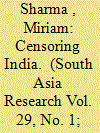

|
|
|
|
|
| Publication |
2009.
|
| Summary/Abstract |
During the early twentieth century, the emerging medium of cinema in British India became a distinctly contested political issue, revealing the tensions and limitations of empire. The record on cinematographic censorship indicates a number of competing interests and changing views, while political transformations and messy realities on the ground defied the efficacy of censorship. Even as many Indian filmmakers sought to convey messages of nationalist aspirations, the perceived need to guard against the revolutionary thoughts of communism and ideas from America that seemed to promote democracy and promiscuity fuelled censorship as a major multivocal imperial policy. Beset by many obstacles, it sought to control the exhibition of both Indian and foreign cinematic productions.
The article seeks to understand the genealogy of censorship derived from prior British attempts to regulate literary and dramatic productions. In the 1920s, anxieties about the maintenance of law and order and protection of British rule during a period of increasing Indian nationalist unrest had to be integrated with various concerns about deteriorating economic conditions. As Indian cinema struggled to come into its own, the issue of control became a central concern for both coloniser and colonised, while both faced threats from the influx of foreign (especially Hollywood) films.
The article also explores why it was deemed so important to bring cinema under the colonial gaze. While there was no unified front on how to deal with this new medium, it was perceived as highly in-fluential, with great potential for harmful or beneficial propaganda impacts. Finally, considerations of the competing demands of moral concerns were juxtaposed to the growing economic needs of the Indian film industry.
Throughout, it transpires from archival research how defining policy issues became ever more critical and how the complexities of implementation were made more difficult by the 'global' nature of policy formation as opposed to the more 'local' nature of the performance of control.
|
|
|
|
|
|
|
|
|
|
|
|
|
|
|
|
| 3 |
ID:
171963
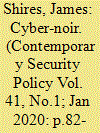

|
|
|
|
|
| Summary/Abstract |
Cybersecurity experts foster a perception of cybersecurity as a gloomy underworld in which the good guys must resort to unconventional tactics to keep at bay a motley group of threats to the digital safety of unsuspecting individuals, businesses, and governments. This article takes this framing seriously, drawing on film studies scholarship that identifies certain aesthetic themes as associated with moral ambiguity in noir films. This article introduces the term “cyber-noir” to describe the incorporation of noir elements in cybersecurity expert discourses. It argues that the concept of cyber-noir helps explain the persistence of practices that blur legal, moral, and professional lines between legitimate and malicious activity in cyberspace. Consequently, changing cybersecurity requires not only institutional and technological measures, but also a re-constitution of cybersecurity identities themselves.
|
|
|
|
|
|
|
|
|
|
|
|
|
|
|
|
| 4 |
ID:
160504
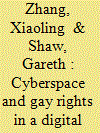

|
|
|
|
|
| Summary/Abstract |
Owing to China’s austere censorship regulations on film media, directors of films and documentaries engaging with lesbian, gay, bisexual and transgender themes have struggled to bring their work to domestic attention. Working outside of the state-funded Chinese film industry has become necessary for these directors to commit their narratives to film, but without approval of China’s State Administration of Press, Publication, Radio, Film and Television, these artists have had little chance of achieving widespread domestic distribution of their work. However, advancements in new media technology and Web 2.0, ranging from digital video formats to Internet-based distribution via social media networks and video-hosting platforms, provide opportunities for Chinese audiences to access films and documentaries dealing with LGBT themes. This empirical study assesses how production, promotion and consumption of queer documentary films are influenced by the development of social media within Chinese cyberspace. Through close readings of microblogs from SinaWeibo, this study combines analysis of contemporary research with digital social rights activism to illustrate contemporary discourse regarding film-based LGBT representation in China. Finally, the study comments on the role that documentary filmmaking plays in China’s gay rights movement, and discusses the rewards (and challenges) associated with increased levels of visibility within society.
|
|
|
|
|
|
|
|
|
|
|
|
|
|
|
|
| 5 |
ID:
124924
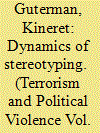

|
|
|
|
|
| Publication |
2013.
|
| Summary/Abstract |
This article considers popular ways of representing terror activists, and the metamorphoses that approaches to representation in the American media have undergone. A part of the article deals with terrorism in the media over time, common stereotypes, and how they affect the representation of Arabs and Muslims. The article then discusses Sleeper Cell (2005), a mini-series which focuses on a Jihad terror group. The article addresses questions including: How are Arabs and non-Arab Muslims portrayed in the series? Can a real change be observed over time in the method of portraying them? Twentieth-century historical considerations precede the pointed topical discussion.
|
|
|
|
|
|
|
|
|
|
|
|
|
|
|
|
| 6 |
ID:
123063
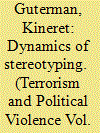

|
|
|
|
|
| Publication |
2013.
|
| Summary/Abstract |
This article considers popular ways of representing terror activists, and the metamorphoses that approaches to representation in the American media have undergone. A part of the article deals with terrorism in the media over time, common stereotypes, and how they affect the representation of Arabs and Muslims. The article then discusses Sleeper Cell (2005), a mini-series which focuses on a Jihad terror group. The article addresses questions including: How are Arabs and non-Arab Muslims portrayed in the series? Can a real change be observed over time in the method of portraying them? Twentieth-century historical considerations precede the pointed topical discussion.
|
|
|
|
|
|
|
|
|
|
|
|
|
|
|
|
| 7 |
ID:
124729
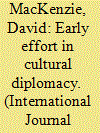

|
|
|
|
|
| Publication |
2013.
|
| Summary/Abstract |
The Canadian Co-operation Project (CCP) was one of the more unusual episodes in the economic and cultural relationship of Canada and the United States. Conceived between the federal government and the Hollywood film industry, the 1948 agreement called on Hollywood to produce more films in Canada and to make efforts to promote American tourism in Canada. The paper argues that the CCP was less the surrender to Hollywood than is generally understood and more an early example of cultural diplomacy in which the Canadian government used cultural relations with the United States for its own ends, primarily the promotion of tourism in Canada
|
|
|
|
|
|
|
|
|
|
|
|
|
|
|
|
| 8 |
ID:
148025


|
|
|
|
|
| Summary/Abstract |
Film production has for a long time been a prominent medium for Palestinians to resist Israeli occupation and create a cultural memory. Though there are some academic studies on the subject, a critical framework of analysis for such films remains underdeveloped. This article argues that Palestinian film production has surged particularly in recent years as part of an increasingly globalised dimension to Palestinian resistance, alongside such initiatives as the Electronic Intifada and the BDS movement. Early Zionist rhetoric asserted the non-existence (or invisibility) of Palestinians. Several decades later, when the Arab revolt was shut down, the Israeli official propaganda largely shifted to a discourse of “emergency”, which decontextualizes the anti-colonial nature of Palestinian resistance. The films 5 Broken Cameras (2011) and Private (2004) both engage with Israeli colonialism and the state of emergency by acting as tools of witnessing, laying bare the occupational strategies the Israelis use under emergency law and revealing the arbitrary nature of such practices as the Separation Wall. The films challenge Israeli authority through their depictions of predominantly non-violent forms of resistance, which counters their historically constructed invisibility as a people, as well as the colonialist narrative of “terrorism”. Non-violent resistance makes the recognition of Israeli authority problematic, as the settlers cannot use brute force to drive out the Palestinians if there is no documented incident in context to justify violence. Furthermore, the article argues that the form of the films – pseudo-documentary and especially “talking witness” documentary – enables their emotive content to reach out to an international audience, which could potentially respond. Thus, the films not only contain acts of resistance, but they significantly are tools of resistance in the conflict.
|
|
|
|
|
|
|
|
|
|
|
|
|
|
|
|
| 9 |
ID:
147822
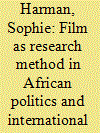

|
|
|
|
|
| Summary/Abstract |
This research note reflects on the use of film as a method in researching politics and international relations in African countries. It is based on the experiences of producing a feature-length drama about the everyday risk of HIV/AIDS, using real people and their stories in Tanzania. The intent of the film, Pili, is to challenge international aesthetics of HIV/AIDS in film and how people understand the complexities and structural politics of disease. It is argued that the film itself is not the only outcome or contribution to knowledge. The external narrative or process of how the film was made, the method of doing, also produces new ways of thinking about ethics, collaboration, and navigating the state in conducting research. The research note makes this argument by first reflecting on the origins and debates of visual method, and then exploring what film as a research method reveals about structure and agency, research collaboration, ethics, and the state.
|
|
|
|
|
|
|
|
|
|
|
|
|
|
|
|
| 10 |
ID:
161646
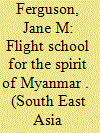

|
|
|
|
|
| Summary/Abstract |
In 1935, two Burmese filmmakers traveled to Tokyo with the intention of acquiring the latest sound recording equipment and training in sound-on-film production. In addition to these stated goals, in Japan they co-produced the feature film Japan Yin Thwe/Nippon Musume, ‘Japanese Darling.’ The film depicts daring young Burmese aviators and a budding romance with a Japanese woman. The active harnessing of the symbolic capital of aviation – the ideological notion of airmindedness – through the mimetic capacities of cinema, could be seen as a prescient example of Pan-Asianism, predating Daitoa Kyoeiken ‘Greater East-Asia Co-Prosperity Sphere’ propaganda. The film’s explicit encouragement of Burmese techno-nationalism offers a compelling contrast to other examples of anti-colonial nationalism, which emphasize notions of ethnic history and Buddhist morality and concerns of religious decline in the face of foreign imperialism. However, a comprehensive analysis of the film industry and commercial aviation in Japan in the 1930s reveals a structural impetus for this collaboration, arguably overshadowing ideological motivations and results.
|
|
|
|
|
|
|
|
|
|
|
|
|
|
|
|
| 11 |
ID:
174164
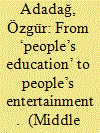

|
|
|
|
|
| Summary/Abstract |
This article analyzes the use of cinema by the People’s Republican Party in the early decades of republican Turkey. It focuses on cinema activities in the People’s Houses, which from 1932 onward opened in different regions of the country and operated as the party’s cultural organ. Relying on a range of archival materials, it shows that from the mid-1930s, cinema came increasingly to be used by the party as a propaganda device for promoting ‘people’s education’; from the mid-1940s, however, the party began to turn to cinema as a source of revenue to keep the People’s Houses financially afloat. While this change owed much to the political and economic conditions of the period following the Second World War, it was equally a product of the different expectations locals had of the cinema, as distinct from those of the People’s House administrators and the party leaders in Ankara. Where the latter group viewed cinema as a tool for ‘people’s education’, People’s House administrators saw it as a source of income, and the locals who visited the People’s Houses saw it as a means of entertainment.
|
|
|
|
|
|
|
|
|
|
|
|
|
|
|
|
| 12 |
ID:
079072
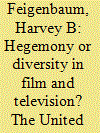

|
|
|
|
|
| Publication |
2007.
|
| Summary/Abstract |
In October 2005 UNESCO produced its Universal Declaration on Cultural Diversity. This was largely a response to the worries of countries, especially in Europe and not least of which France, which feared the damaging effects to their cultures if trade in entertainment products remained too one-sided. Generally the argument of this paper is that while initial tensions between the United States and Europe were motivated by the usual commercial concerns, Europeans were increasingly worried about the cultural impact of this commerce. The Japanese, however, have not been nearly so concerned as the Europeans about becoming 'Americanized'. This lack of tension between the United States and Japan in the area of film and television is due to several factors. First, there is a complementarity between American entertainment and the Japanese electronics industry. Second, the Japanese are major players in some aspects of the entertainment industry, most especially in the area of animation, and they are especially influential in Asia. Finally, issues of cultural conflict between the United States and Japan are simply less salient to Tokyo than those which characterize Japan's relations with its Asian neighbors
|
|
|
|
|
|
|
|
|
|
|
|
|
|
|
|
| 13 |
ID:
172448
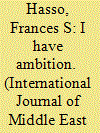

|
|
|
|
|
| Summary/Abstract |
This article provides a close reading of two popular Egyptian action films, al-Almani (The German, 2012), the first blockbuster since the 25 January 2011 revolution, and Qalb al-Asad (Lion heart, 2013), both starring Muhammad Ramadan as a socially produced proletarian “thug” figure. Made for Egyptian audiences, the films privilege entertainment over aesthetics or politics. However, they express distinct messages about violence, morality, and revolution that are shaped by their moments of postrevolutionary release. They present the police state in salutary yet ambivalent terms. They offer a rupture with prerevolutionary cinema by staging the failure of proletarian masculinities and femininities that rely on middle-class respectability in relation to sex, marriage, and work. Even as each film expresses traces of revolutionary upheaval and even nostalgia, cynicism rather than hopefulness dominates, especially in al-Almani, which conveys to the middle and upper classes the specter of an ever-present threat of masculine frustration. The form and content of Qalb al-Asad, by comparison, offer the option of reconciling opposing elements—an Egyptian story line with a less repressive conclusion if one chooses a path between revolutionary resistance and accepting defeat.
|
|
|
|
|
|
|
|
|
|
|
|
|
|
|
|
| 14 |
ID:
090278
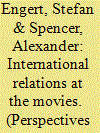

|
|
|
| 15 |
ID:
190717
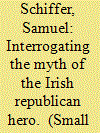

|
|
|
|
|
| Summary/Abstract |
This essay seeks to understand how since the signing of the Good Friday Agreement in 1998, marking the end of The Troubles in Northern Ireland, filmic depictions of the conflict reinterpret and interrogate the traditional role of the ‘hero’ in the Irish republican cause. In an analysis of two films released after the Good Friday Agreement, Hunger (2008) and The Wind that Shakes the Barley (2006), this essay argues that both films feature a hero-type Irish republican waging a brave-but-futile campaign against British oppression, but critique the myth of the Irish republican hero by severing the cycle of mythical violence by sowing doubt in the hero myth that serves as its base. This essay suggests that film is a low-stakes arena for the interrogation of volatile narratives that plays an important role in the reconceptualization of a conflict and, maybe even, its resolution.
|
|
|
|
|
|
|
|
|
|
|
|
|
|
|
|
| 16 |
ID:
095103
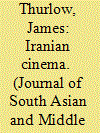

|
|
|
| 17 |
ID:
101641
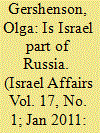

|
|
|
|
|
| Publication |
2011.
|
| Summary/Abstract |
The mass immigration from the Former Soviet Union (FSU) changed both the Israeli and Russian cultures. Since the 1990s, Russian immigrants and their homeland began appearing in Israeli films. Meanwhile, Jewish themes, including emigration, became more common in Russian cinema: Israel now appears in Russian films. Whether Russian or Israeli, these movies circulate through the internet, transnational TV channels, and Jewish film festivals, and are seen in Russia and elsewhere in the Russian diaspora. This shows that cultural processes in today's globalized mediated world are interrelated: as Russian-Jewish immigrants transform themselves through migration, they also transform cultures around them.
|
|
|
|
|
|
|
|
|
|
|
|
|
|
|
|
| 18 |
ID:
107539
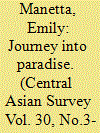

|
|
|
|
|
| Publication |
2011.
|
| Summary/Abstract |
In 2003, a Tajik film crew was permitted to cross the tightly controlled border into Afghan Badakhshan in order to film scenes for a documentary entitled Sacred Traditions in Sacred Places. Although official Tajik state policies and international non-governmental organizations have increasingly stressed freer movement and greater connectivity between the two sides, this 'prescribed community' strongly contrasts with the lived experience of Tajik Badakhshanis. This article explores narratives of nostalgia and dissonance reflected in the film itself and recounted by the film crew in interviews during film production and screening. Engaging with existing work on the interpretation and temporalization of space and post-Soviet nostalgias, I claim that this particular nostalgia emerges in response to new configurations of power and newly imposed pressures valuing cross-border movement. In this case, nostalgia serves as an affective resource helping Tajik Badakhshanis understand and manage daily life and the new potential for border crossing in a highly regulated border zone.
|
|
|
|
|
|
|
|
|
|
|
|
|
|
|
|
| 19 |
ID:
155294


|
|
|
|
|
| Summary/Abstract |
In recent years, many international relations scholars have been discussing films, books, and television programs featuring zombies, largely because such narratives are thought to provide a compelling metaphor for thinking about a diverse array of contemporary threats. These range from relatively traditional threats posed by violent terrorists to nontraditional threats from epidemics or mass migration. However, because zombie narratives are generally apocalyptic, employing them can provide a misleading and dangerous understanding of international security. By contrast, satirical and comedic zombie stories provide interesting alternative narratives that coincide with the emancipatory objectives of critical security studies. Satirical narratives focusing on elites characteristically critique these powerful figures, often revealing them to be self-centered buffoons. Indeed, satire and black comedy can be quite subversive, reflecting critical and potentially transformative notions—about threats and other dimensions of security politics. Comedies typically center upon ordinary people, emphasize their regular lives, and end happily—aligning with the aspirations of the human security agenda.
|
|
|
|
|
|
|
|
|
|
|
|
|
|
|
|
| 20 |
ID:
139301
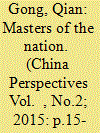

|
|
|
|
|
| Summary/Abstract |
Cinema, an extremely popular and useful cultural form during the Maoist era, played a big role in shaping working class subjectivity. This article argues that despite their highly politicised and formalised content, industrial-themed films made during the Cultural Revolution created a “masters of the nation” subjectivity that still resonates with workers who grew up watching these films. In doing so, this article brings together two bodies of scholarship that rarely make reference to one another: filmmaking in the Cultural Revolution period and post-Mao workers’ subjectivity. Post-Mao scholarship has gone beyond simply dismissing films from the Cultural Revolution period as crude propaganda designed to create a highly politicised mass mind. It has drawn our attention to the more complicated nature of this body of filmmaking, particularly the “model play” films. However, new features made during the Cultural Revolution are often seen as “too ideological” to warrant academic attention. This paper attempts to find out how the “masters of the nation” discourse still resonates with workers who grew up watching these films. It argues that, despite the valorisation of workers as the privileged class and an excessive focus on class struggle, these films have indeed endowed the subaltern with the kind of agency that is lacking in contemporary media representations of workers.
|
|
|
|
|
|
|
|
|
|
|
|
|
|
|
|
|
|
|
|
|